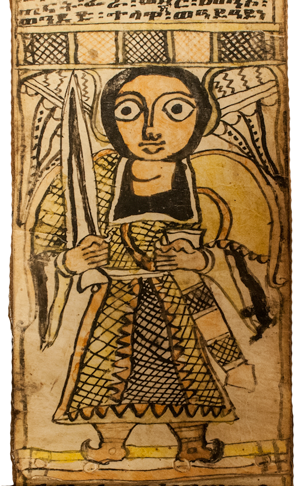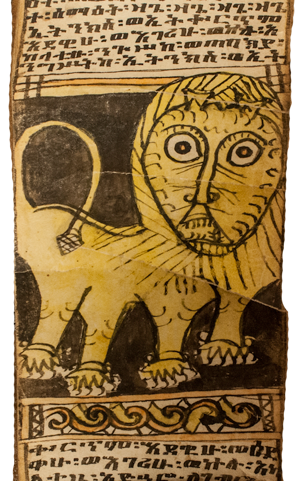Mad in Pursuit Notebook
Ethiopian Healing Scrolls
(#413-415 Ethiopian scrolls)

So I found the scrolls. What are they about? What do they mean?
Each scroll is custom-designed for an individual who is suffering from an ailment. In conjuntion with herbal cures and other interventions, spiritual counsel is sought from a dabtara. The mind-body-spirit healing process begins with a sacrificial meal and the resulting goat or sheep skin is ritually stretched and dried to a thin vellum. The vellum is cut into strips as wide as the client can afford and stitched together as long as the client is tall (so that he or she can be protected from head to toe).
 The scroll is then filled with text and drawings. They may be permanently sealed into a leather pouch for wearing or stored in a metal phylactery or amulet case for handy availability [like the one in our photo]. Or they may be hung on the center post of the house facing the door, to warn away evil spirits.
The scroll is then filled with text and drawings. They may be permanently sealed into a leather pouch for wearing or stored in a metal phylactery or amulet case for handy availability [like the one in our photo]. Or they may be hung on the center post of the house facing the door, to warn away evil spirits.
I should back up to say that Ethiopia is a well-cooked stew of religious traditions—Christian (since mid 4th century), Jewish, Islamic, and Pagan. And each of these traditions have historically made use of the services of the dabtara and the protective power of the scrolls. From what I can gather, the traditional dabtara is an unordained cleric in the Ethiopian Orthodox tradition. He goes through the same religious training as priests, but goes on to study singing, poetry, literature and folk medicine. He is expected to work within the confines of Christian dogma, but finds ways of blending in astrology and unorthodox talismans, according to the patients' needs.
The paintings below are from our widest (4-3/4") scroll. I'm looking at a book from our Africa shelf: Ethiopian Magic Scrolls—to see what I can learn about them.
Gallery

1 (above). At the start of the scroll is a 16-box composition, with additional design elements above and below. There are four four-petal rosettes which can be seen as coptic crosses; 4 X-motifs; and 4 faces. Four is a common number in talismanic symbolism: 4 Evangelists, 4 directions, etc. The X-motif, combined with prayers, is said to have the virtue of undoing spells. The faces might be angels... they look just like the pleasant face in the next image.

2. A guardian angel, brandishing his sword.

3. A lion. The only lions mentioned in my book are those associated with the hermit Abba Samuel, who took care of them and removed splinters from their feet.

4. The last drawing on the scroll is obviously a cross but I can't quite read the symbolism. Looks like it is on an anchor. Has it broken the spear? Or is it a three-part (trinitarian) symbol?
I get fascinated with these things, but can only take them so far.
References
Ethiopian Magic Scrolls by Jacques Mercier (NY: George Braziller, 1979)
Ethiopian Healing Scrolls, Heilbrun Timeline of Art History Essay by Kristen Windmuller-Luna (Department of Art and Archaeology, Princeton University) April 2015. Metropolitan Museum of Art, NYC.
Healing Scroll: Amhara or Tigrinya peoples, description by Kristen Windmuller-Luna, Metropolitan Museum of Art, NYC.
(Originally posted 31 Aug 31 2012. Updated 23 Nov 2023.)
...
FOLLOW me on my Facebook page, share this post to your friends, and....
Books from Mad in Pursuit and Susan Barrett Price: KITTY'S PEOPLE: the Irish Family Saga about the Rise of a Generous Woman (2022)| HEADLONG: Over the Edge in Pakistan and China (2018) | THE SUDDEN SILENCE: A Tale of Suspense and Found Treasure (2015) | TRIBE OF THE BREAKAWAY BEADS: Book of Exits and Fresh Starts (2011) | PASSION AND PERIL ON THE SILK ROAD: A Thriller in Pakistan and China (2008). Available at Amazon.